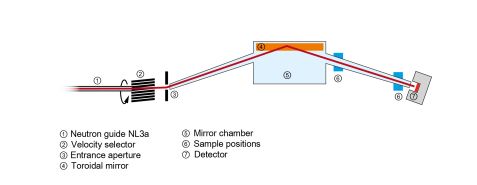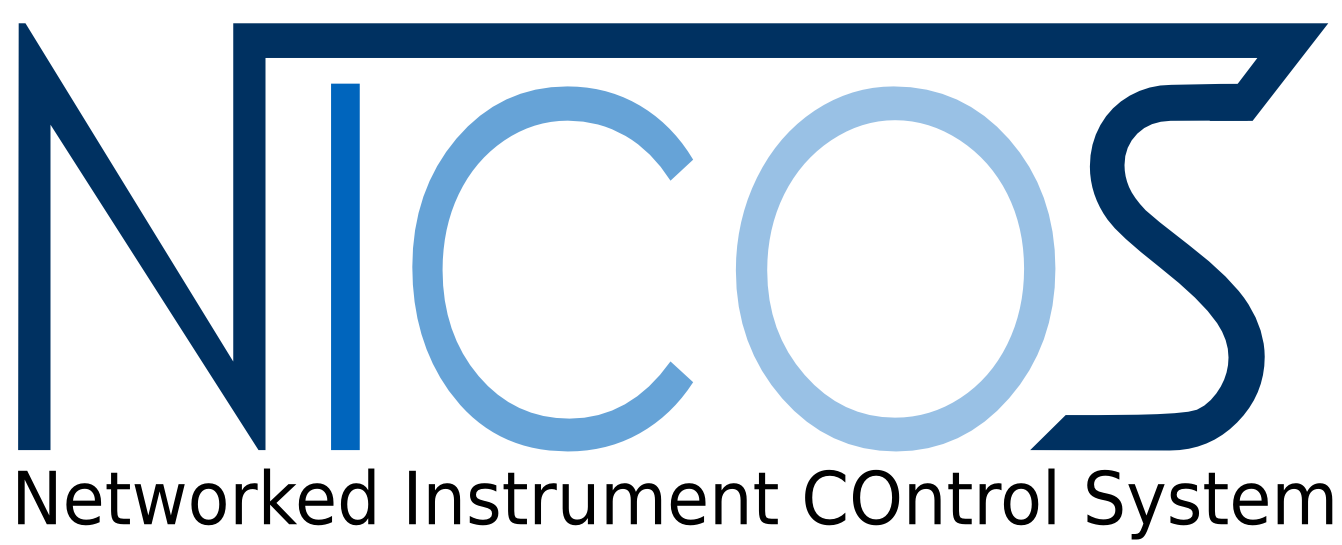MLZ is a cooperation between:
 > Technische Universität München
> Technische Universität München > Helmholtz-Zentrum Hereon
> Helmholtz-Zentrum Hereon
 > Forschungszentrum Jülich
> Forschungszentrum Jülich
MLZ is a member of:
 > LENS
> LENS > ERF-AISBL
> ERF-AISBL
MLZ on social media:

MLZ (eng)
Lichtenbergstr.1
85748 Garching
KWS-3 ‚VerySANS‘
Very small angle scattering diffractometer with focusing mirror
This instrument is focussed on cold neutrons. All parameters given here are valid during the current operation of FRM II. Please get in touch with the instrument team well in advance for all further details (length of experiment etc.).
KWS-3 is a very small angle neutron scattering (VSANS) instrument running on the focusing mirror principle. The instrument is designed to bridge the gap between Bonse-Hart and pinhole cameras. Some details of the diffractometer operation are explained in fig. 1 (see gallery): the principle of this instrument is a one-to-one image of an entrance aperture onto a 2D position sensitive detector by neutron reflection from a double-focusing toroidal mirror.
The instrument’s standard configuration “VSANS” with a 9.3 m sample-to-detector-distance (SDD) and 2 × 2 mm2 entrance aperture (EA) allows performing scattering experiments with a wave vector transfer resolution between 1.0 · 10-4 and 2.5 · 10-3 Å-1.
‘VerySANS’ is a focusing instrument. Unlike at a pinhole SANS instrument, we can not improve the dynamical range (Qmax/Qmin) by moving the detector: the position of the KWS-3 detector is fixed in the right focus as shown in fig. 1. At KWS-3, we extended the dynamical range by ‘replicating’ of the sample positions at different distances between the sample and the detector. Such kind of ‘Multi-sample-position-approach’ (fig. 2) is completed in 2021.
Compact sample environment (SE) (gallery, tab. 1 and fig. 3a): We can install a compact SE (volume below 30 × 30 × 30 cm3) inside two vacuum chambers located at SDD = 9.3 and 1.7 m; as well as those samples can be measured in the close vicinity of the detector (SDD = 0.05 – 0.40 m). In tab 1, all parameters of configurations in case of the compact SE are listed. The combination of several configurations, called “USANS”, “VSANS”, “SANS-overlap” and “SANS” allows performing scattering experiments with a wave vector transfer resolution between 3.5 · 10-5 and 3.5 · 10-1 Å-1, covering four decay of the dynamical range.
Bulky sample environment (SE) (gallery, tab. 2 und fig. 3a): In the current instrument configuration, we can install a bulky SE at SDD = 10, 4, 3, and 2 m. At these positions we can precisely positioning as well rotate and tilt a sample together with a bulky/ heavy SE. A sample in a few Tesla magnetic field or under shear in the rheometer can be measured within q-range between 3.5 · 10-5 and 10-2 Å-1.
The instrument covers the Q range of small angle light scattering instruments. Especially when samples are turbid due to multiple light scattering, VSANS gives access to the structural investigation. Thus, the samples do not need to be diluted. The contrast variation method allows for highlighting of particular components.
Small-angle scattering is used for the analysis of structures with sizes just above the atomic scale, between 1 and about 100 nm, which cannot be assessed or sufficiently characterised by microscopic techniques. KWS-3 is an important instrument extending the accessible range of scattering angles to very small angles with a superior neutron flux when compared to a conventional instrumental setup with pinhole geometry. Thus, the length scale that can be analysed is extended beyond 10 μm for numerous materials from physics, chemistry, materials science, and life science, such as alloys, diluted chemical solutions, and membrane systems.
- Aggregation in colloidal dispersions
- Self-assembling of polymers
- Hierarchical structures of biominerals
- Hydrogels and aerogels
- Membrane systems
- Rheology and structure/morphology of complex fluids
- Morphology of vortex lattice domains
- Surface and interface structure
- Porous structure & gas storage in rocks
- In-situ study of solid phase transition/crystallisation at high temperature
- Colloid science: mixtures of particles, particles of micron size, silicon macropore arrays
- Materials science: filled polymers, cements, microporous media
- Polymer science: constrained systems, emulsion polymerization
- Bio science: aggregations of bio-molecules, protein complexes, crystallisation of proteins
- Multilamellar vesicles
- Neutron polarisation & polarisation analysis
- Anton-Paar fluid rheometer
- Stopped flow mixer with UV-Vis and fluorescence detector
- Different RT-sample holders
- Oil & water thermostats (typical 5 – 150°C)
- Electric thermostat (RT – 200°C)
- 6/8-positions Peltier sample holder (-10 – 150°C)
- Magnet (2 T, vertical)
- Magnet (3 T, horizontal)
- Cryostat with sapphire windows
- High temperature furnace (RT – 2000°C)
- Pressure cells (500 bar, 2000 bar, 5000 bar)
- Humidity generator and humidity cells (0 – 90 RH %)
- Linkam Modular Force Stage (tensile testing at various temperature and humidity)
- MgLi velocity selector
- Wavelength spread Δλ/λ = 0.17
- Wavelength range λ = 10.5 – 30 Å (maximal flux at 12.8 Å)
- 0 × 0 – 10 × 10 mm2
- 0.7 × 0.7 mm2 (“USANS” modes with VHRD)
- 2.0 × 2.0 mm2 (“VSANS” and “SANS” modes with HRD: “high resolution” mode)
- 4.0 × 4.0 mm2 (“VSANS” and “SANS” modes with HRD: “high intensity” mode)
- HRD:
- Type: Scintillator, 6Li, 1 mm
- Active area: ∅ 9.0 cm
- Pixel size: 0.34 : 0.34 mm2
- Dead-time: 2.9 μs
- Matrix Dim.: 256 × 256
- VHRD:
- Type: Scintillator, 6Li, 1 mm
- Active area: 3 × 3 cm2
- Pixel size: 0.12 : 0.12 mm2
- Dead-time: 2.7 μs
- Matrix Dim.: 256 × 256
- 3.5 · 10-5 – 3.5 · 10-1 Å-1 (Compact SE, tab. 1)
- 3.5 · 10-3 – 1.2 · 10-2 Å-1 (Bulky SE:, tab. 2)
- Several samples measured at KWS-3 are shown in fig. 3b (see gallery)
- All possible instrument configurations are listed in tab. 1 and 2 (see gallery)
- “USANS”, “USANS-10m” and “SANS” configurations:
- currently only very strongly scattering samples can be measured
- simulated intensity of “VSANS” and “SANS-overlap” configurations
- 1200 n s-1 (in “high resolution” mode with EA = 2 × 2 mm2)
- 4800 n s-1 (in “high intensity” mode with EA = 4 × 4 mm2)
Instrument Scientists
Dr. Vitaliy Pipich
Phone: +49 (0)89 158860-710
E-Mail: v.pipich@fz-juelich.de
Dr. Baohu Wu
Phone: +49 (0)89 158860-687
E-Mail: ba.wu@fz-juelich.de
KWS-3
Phone: +49 (0)89 158860-513
Operated by

Publications
Find the latest publications regarding KWS-3 in our publication database iMPULSE:
Citation of the instrument
Heinz Maier-Leibnitz Zentrum. (2015). KWS-3: Very small angle scattering diffractometer with focusing mirror. Journal of large-scale research facilities, 1, A31. http://dx.doi.org/10.17815/jlsrf-1-28
For citation please always include the DOI.
Instrument control
Gallery






MLZ is a cooperation between:
 > Technische Universität München
> Technische Universität München > Helmholtz-Zentrum Hereon
> Helmholtz-Zentrum Hereon
 > Forschungszentrum Jülich
> Forschungszentrum Jülich
MLZ is a member of:
 > LENS
> LENS > ERF-AISBL
> ERF-AISBL
MLZ on social media:





